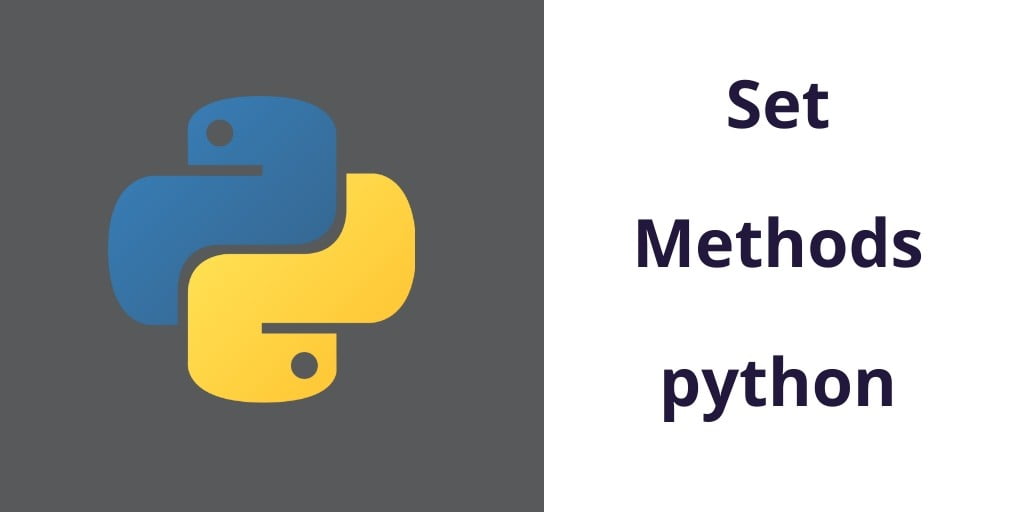In the previous tutorial, you learned how to use in-built dictionary methods in your Python program. But, In this post, you will learn python built-in set methods/functions.
If you want to know more about python sets click here.
Python Sets built-in Functions/Methods
Python provides many in-built methods/functions for the sets, which is works with python set datatype. And you can modify and manipulate the python sets by using built-in sets methods/functions of python.
We have provided a list below. Almost all built-in sets methods/functions python are there:
| Method | Description |
|---|---|
| add() | Adds an element to the set |
| clear() | Removes all the elements from the set |
| copy() | Returns a copy of the set |
| difference() | Returns a set containing the difference between two or more sets |
| difference_update() | Removes the items in this set that are also included in another, specified set |
| discard() | Remove the specified item |
| intersection() | Returns a set, that is the intersection of two other sets |
| intersection_update() | Removes the items in this set that are not present in other, specified set(s) |
| isdisjoint() | Returns whether two sets have a intersection or not |
| issubset() | Returns whether another set contains this set or not |
| issuperset() | Returns whether this set contains another set or not |
| pop() | Removes an element from the set |
| remove() | Removes the specified element |
| symmetric_difference() | Returns a set with the symmetric differences of two sets |
| symmetric_difference_update() | inserts the symmetric differences from this set and another |
| union() | Return a set containing the union of sets |
| update() | Update the set with the union of this set and others |
Python Set add()
The set add() method adds a given element to a set. If the element is already present, it doesn’t add any element.
# set of numbers
num = {1, 2, 3, 4}
# adding '5'
num.add(5)
print('numbers are:', num)
# adding '5' again
num.add(5)
print('numbers are:', num)
#output
#numbers are: {1, 2, 3, 4, 5}
#numbers are: {1, 2, 3, 4, 5}
Python Set clear()
The clear() method is used to remove all elements from the set.
# set of numbers
num = {1, 2, 3, 4}
# clear list
num.clear()
print('numbers are:', num)
#Output
#numbers are: set()
Python Set copy()
The copy() method is used to copy the set.
# set of numbers
num = {1, 2, 3, 4}
# copy list
x = num.copy()
print('numbers are:', x)
#output
#numbers are: {1, 2, 3, 4}
Python Set remove()
The remove() method is used to search for the given element in set list and remove it.
# set of numbers
num = {1, 2, 3, 4}
# remove element from list
num.remove(2)
print('numbers are:', num)
#Output
#numbers are: {1, 3, 4}
Python Set discard()
The discard() method is used to remove a specific element from the set. If the element present in the python set list.
numbers = {2, 3, 4, 5}
numbers.discard(3)
print('numbers = ', numbers)
numbers.discard(10)
print('numbers = ', numbers)
#outout
#numbers = {2, 4, 5}
#numbers = {2, 4, 5}
Python Set pop()
The pop method is used to remove a random element from the set.
# set of numbers
st = {'a', 'v', 'c', 'g', 'j'}
# remove element from list
st.pop()
print('elements are:', st)
#output
#numbers are: elements are: {'c', 'g', 'a', 'j'}
Python Set difference()
The difference() method is used to get the difference between two python sets.
Python Set update()
The python set update() method is used to add elements/items from another set.
x = {"1", "2", "3"}
y = {"4", "5", "6"}
x.update(y)
print(x)
#Output
#{'2', '4', '6', '3', '1', '5'}
Python Set isdisjoint()
The isdisjoint() method returns True if two sets are disjoint sets. If not, it returns False.
A = {1, 2, 3, 4}
B = {5, 6, 7}
C = {4, 5, 6}
print('Are A and B disjoint?', A.isdisjoint(B))
print('Are A and C disjoint?', A.isdisjoint(C))
#Output
#Are A and B disjoint? True
#Are A and C disjoint? False
Python Set intersection()
The intersection () method uses two or more sets to extract a similar element and create a new set.
x = {1, 2, 3}
y = {3, 4, 5}
z = x.intersection(y)
print(z)
#output
#3
Python Set issubset()
The issubset() method returns results True. If all elements of a set are present in another set. If is not present in another set, it returns False.
A = {1, 2, 3}
B = {1, 2, 3, 4, 5}
C = {1, 2, 4, 5}
# Returns True
print(A.issubset(B))
# Returns False
print(B.issubset(A))
Python Set symmetric_difference()
The Python symmetric_difference() method is used to get the symmetric difference of two sets.
x = {'x', 'y', 'c', 'd'}
y = {'c', 'd', 'e' }
z = {}
print(x.symmetric_difference(y))
print(y.symmetric_difference(x))
print(x.symmetric_difference(z))
print(y.symmetric_difference(z))
#output
#{'x', 'e', 'y'}
#{'x', 'e', 'y'}
#{'x', 'c', 'y', 'd'}
#{'d', 'e', 'c'}
